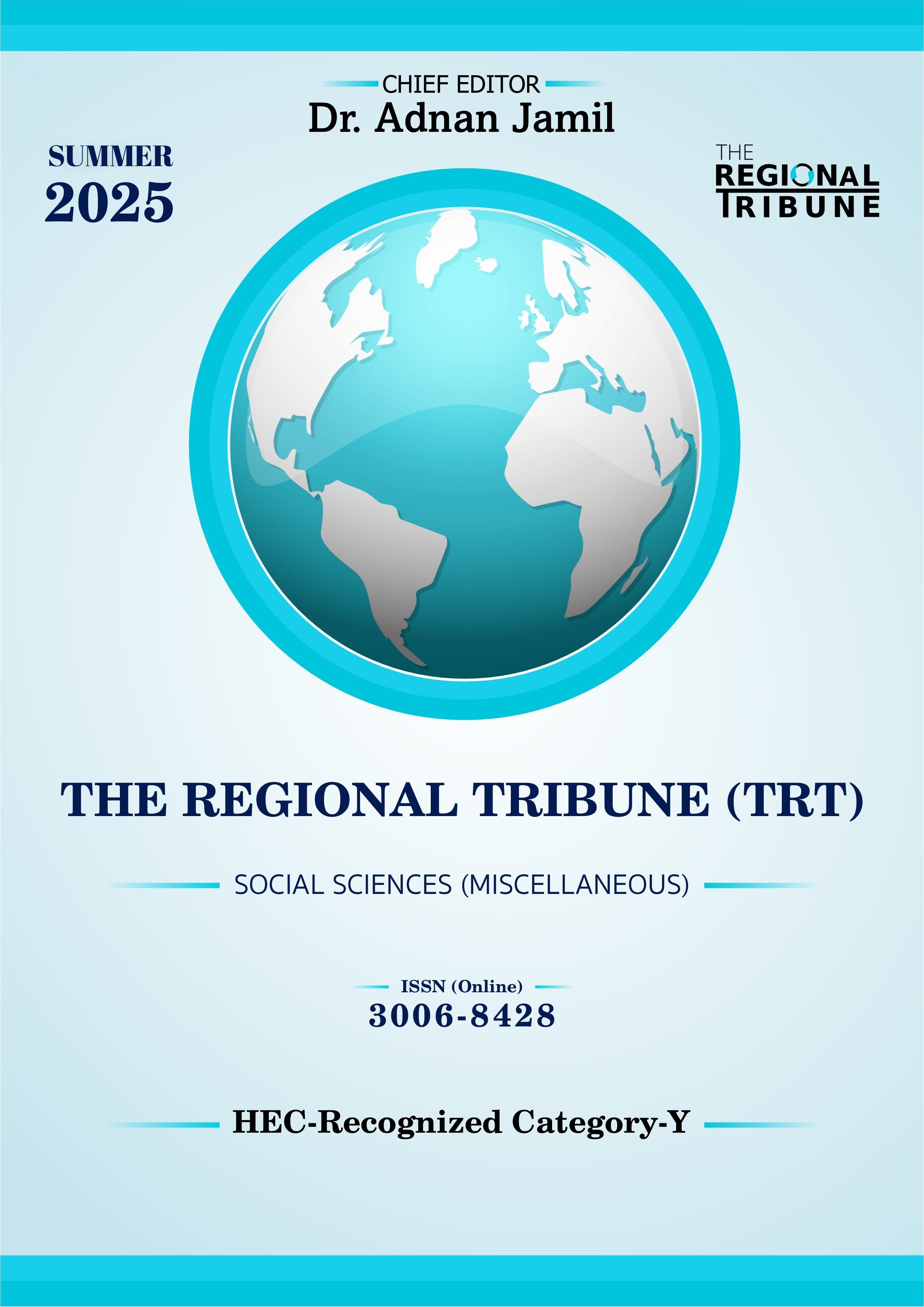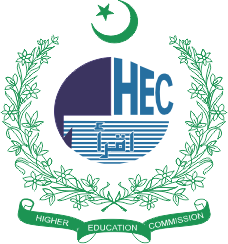From Learning to Leadership: The Role of Civil Society and Peace Education on Socio-Political Change in Pakistan
DOI:
https://doi.org/10.55737/trt/SR25.106Keywords:
Holistic Peace, Out-of-school-children, Peace Education, Civil Society, Socio-Political ChangeAbstract
For holistic peace in any society, a sustainable socio-political change is required that needs integration of all stakeholders. To achieve this goal, educating the youth can play a vital role. In Pakistan, more than 48.4% among the total youth aged 5-16 years are out-of-school. Such a large number of children needs schools equal to what Pakistan could build since its independence in 1947, leaving a gap for civil society to fill. Therefore, the current study aims to explore the role of Peace education and civil society in bringing a positive socio-political change in Pakistan. The study takes data through semi-structured interviews from the founding members of two Islamabad based civil society organisations (CSOs) and peace education experts. Secondary data is gathered from the official websites of relevant organizations. The findings reveal that CSOs in Pakistan are actively working to empower the youth through educating the uneducated mostly using traditional education system as well as grooming the learned. The study recommends that CSOs needs to incorporate peace education which is more important for bringing socio-political awareness and positive peace in a society.
References
Abbas, M. J. D. Q., Javid M., & Husssain, S. (2021). Low literacy rate at primary level: Identification of causes and impacts. Pakistan Social Sciences Review, 5(2), 492-506. https://doi.org/10.35484/pssr.2021(5-II)39
Apple, M. W. (2012). Can education change society? Routledge. https://doi.org/10.4324/9780203083550
Aziz, M., Bloom, D. E., Humair, S., Jimenez, E., Rosenberg, L., & Sathar, Z. (2014). Education System Reform in Pakistan: Why, When, and How? Www.econstor.eu. https://www.econstor.eu/handle/10419/91762
Balsano, A. B. (2005). Youth civic engagement in the United States: Understanding and addressing the impact of social impediments on positive youth and community development. Applied developmental science, 9(4), 188-201. https://doi.org/10.1207/s1532480xads0904_2
Bornstein, D., & Davis, S. (2010). Social entrepreneurship: What everyone needs to know. Oxford University Press.
Chambers, S. (2002). A critical theory of civil society. Alternative conceptions of civil society, 1, 90.
Colás, A. (2013). International civil society: Social movements in world politics. John Wiley & Sons.
Dike, V. E., & Dike, N. I. (2017). Youth Development and Conflict Resolution in Nigeria:" Assessment and Intervention Strategies". Asian Journal of Education and Training, 3(1), 30-42. http://dx.doi.org/10.20448/journal.522/2017.3.1/522.1.30.42
Economic Growth in Pakistan. (2023) Focus Economics. Barcelona Spain. https://www.focus-economics.com/country-indicator/pakistan/gdp/
Edwards, M. (2009). Civil society. Polity.
FAFEN Analysis of Voter Turnout, Islamabad. (2024). https://fafen.org/fafen-analysis-of-voter-turnout/
Fonseca, M. (2016). Gramsci's critique of civil society: towards a new concept of hegemony. Routledge,
Freire, P., & Macedo, D. (2005). Literacy: Reading the word and the world. Routledge. https://doi.org/10.4324/9780203986103
Gibbon, P. (1998). Some reflections on ‘civil society’and political change. In Democratization in the Third World: Concrete cases in comparative and theoretical perspective (pp. 23-56). London: Palgrave Macmillan UK https://doi.org/10.1007/978-1-349-26783-5_2.
Gill, A. (2022). Accelerated Learning Programme (ALP); a viable solution to growing out-of-school children’s crises in Pakistan | School of Education. Soe.lums.edu.pk. https://soe.lums.edu.pk/news/accelerated-learning-programme-alp-viable-solution-growing-out-school-childrens-crises
Helmut, K., & Anheier, (2005). “A dictionary of civil society, philanthropy and the third sector.” Routledge, https://library.oapen.org/bitstream/handle/20.500.12657/33774/458944.pdf?sequenc#page=123
ILO, (2023). “ILO forecasts Pakistan unemployment up 1.5 million since 2021.” https://www.ilo.org/resource/news/ilo-forecasts-pakistan-unemployment-15-million-2021
International Foundation for Education, Empowerment and Learning Islamabad (IFEEL) (2024). https://ifeel.pk/
Jahan, M. (2021). The Role of Civil Society Organizations and Political Participation of Youth in Pakistan. Global Political Review, VI(IV), 43-53. https://doi.org/10.31703/gpr.2021(VI-IV).05
Kim, S. (2002). Korean Society: Civil Society, Democracy and the State (Civil Society and Democratization). https://scholar.korea.ac.kr/handle/2021.sw.korea/10081
Kim, S. (2003). Civil Society in Democratizing Korea. In S. S. Kim (Ed.), Korea’s Democratization (pp. 81–106). chapter, Cambridge: Cambridge University Press.
Lauder, H., & Brown, P. E. N. C. E. (1991). Education, Economy and Social Change”. International Studies in Sociology of Education, 1(1-2), 3-23.
Maize, J. (2024). Pakistan’s Fastest Accelerated Learning Program. https://lpf.org.pk/accelerated-learning-program/
Makki, M., & Akash, S. A. (2023). Poverty, regional inequality, and the role of governance: tracing geographies of violent extremism in Pakistan. GeoJournal, 88(3), 2635-2650. https://doi.org/10.1007/s10708-022-10766-6
Mustary, M. (2022). Collaborative Governance and Civil Society: A Comparison between Japan and Bangladesh Educational Policies. Bulgarian Comparative Education Society. https://files.eric.ed.gov/fulltext/ED622687.pdf
National Education Foundation. (2017). Ministry of Federal Education and Professional Training. National Education Foundation Yearbook (2017-18). https://www.mofept.gov.pk/
NCHD (2023). National Commission for Human Development Report 2023. https://hdr.undp.org/system/files/documents/global-report-document/hdr2023-24reporten.pdf
NFEMIS Report (2020-21). Out of School Children in Pakistan. https://www.nfemis.net/Default.aspx?ReturnUrl=%2f
O’Neill A. (2024). “Pakistan: Average age of the population from 1950 to 2100 (Median age in years).” https://www.statista.com/statistics/383227/average-age-of-the-population-in-pakistan/
Pakistan Demographic and Health Survey. (2017-18). https://dhsprogram.com/pubs/pdf/FR354/FR354.pdf
Pakistan Economic Survey 2022-23. (2024). https://www.finance.gov.pk
Pakistan Economic Survey, 2022-23. (2023). Pakistan Institute of Education, Economic Adviser’s Wing, Finance Division. https://www.finance.gov.pk
Pakistan Education Statistics for the year 2021-22. (2022). Pakistan institute of Education, https://stateofchildren.com/pakistan-education-statistics-2021-22-highlights-report/
Pakistan Institute of Education Statics for 2021-22. (2024). https://pie.gov.pk/SiteImage/Downloads/PES%202021-22%20reduced.pdf
Patil, M. (2016). Aggression and frustration level of high school children in relation to their montessori and traditional method of education. International Journal of Scientific Research, 5(1), 594-597. https://www.worldwidejournals.com/international-journal-of-scientific-research-(IJSR)/recent_issues_pdf/2016/January/January_2016_1451994467__185.pdf
Punyaratabandhu, S. (2004). Commitment to good governance, development and poverty reduction: methodological issues in the evaluation of progress at the national and local levels. UN.
Qureshi, Z. (2024). “Report unveils 26.2m children are out of school in Pakistan”. Pakistan Observer.
Rehman, M. A. (2023, December 19). Pakistan’s Socioeconomic Problems and Child Labour. Research Society of International Law | RSIL. https://rsilpak.org/2023/how-pakistans-socioeconomic-problems-are-leading-to-child-labour/
TCF Pakistan (2024) Change begins with Education: Embedding schools in the heart of urban slums and rural communities. https://www.tcf.org.pk/
The Black Hole Islamabad. (2024). https://theblackhole.pk/
The World Bank Report (2023). World Bank Report on Poverty in Pakistan during 2023. https://databankfiles.worldbank.org/public/ddpext_download/poverty/987B9C90-CB9F-4D93-AE8C-750588BF00QA/current/Global_POVEQ_PAK.pdf
Tin, H. (2008). Myanmar education: Challenges, prospects and options. Dictatorship, disorder and decline in Myanmar, 113-126. https://library.oapen.org/bitstream/handle/20.500.12657/33774/458944.pdf?sequenc#page=123
UN Report on the Status of Women in Pakistan. (2023). https://pakistan.unwomen.org/en/digital-library/publications
UNICEF (2023). Out of School Children in Pakistan. https://www.unicef.org/pakistan/media/5841/file/Pakistan-2023-COAR.pdf.pdf
UNICEF Report (2023). https://www.unicef.org
Yaseen, Z., & Muzaffar, M. (2018). Extremism in Pakistan: Issues and challenges. Journal of Politics and International Studies, 4(01), 31-42. https://jpis.pu.edu.pk/45/article/view/30
Yousuf, H. (2024). “Young voters.” Dawn. https://www.dawn.com
Zharkevich, I. (2010). The role of civil society in promoting political accountability in fragile states: The case of Tajikistan. Universitäts-und Landesbibliothek Sachsen-Anhalt. https://www.intrac.org/app/uploads/2018/11/The-Role-of-Civil-Society-in-Promoting-Political-Accountability-in-Fragile-States.pdf
Downloads
Published
Issue
Section
License
Copyright (c) 2025 Muhammad Ayaz

This work is licensed under a Creative Commons Attribution-NonCommercial 4.0 International License.



